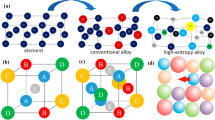Abstract
Strengthening after large deformations by wire-drawing or rolling of Cu, Nb and Cu-20% Nb was compared with the predictions of a proposed modified substructural strengthening model for ductile two-phase alloys. The comparisons indicate that the more extensive and refined model of Funkenbusch and Courtney offers no improvement over the original model of Ashby in predicting the strengthening with increased deformation processing or the dislocation densities necessary to produce the observed strengthening in Cu-20% Nb. Both models can predict the strengthening behaviour of Cu-20% Nb. However, neither model is in accord with the observations that the dislocation density in the Cu matrix is essentially independent of the degree of deformation processing, and that the magnitudes of the dislocation density are much the same in the Cu in Cu-20% Nb and pure Cu identically deformation-processed. In addition, there is no experimental support for the Funkenbusch and Courtney model prediction of an order of magnitude greater dislocation density in the Nb filaments than in the Cu matrix in Cu-20% Nb. It appears that a mechanism that does not require an accumulation of dislocations for strengthening, such as the difficulty in propagating dislocations between closely spaced barriers, is more likely to be responsible for strengthening in Cu-Nb-type deformation-processed composites.
Similar content being viewed by others
References
W. A. Spitzig, J. D. Verhoeven, C. L. Trybus and L. S. Chumbley, Scripta Metall. 24 1171.
Idem, ibid. 24 (1990) 1181.
P. D. Funkenbusch and T. H. Courtney, ibid. 24 (1990) 1175.
Idem, ibid. 24 (1990) 1183.
Idem 33 (1985) 913.
Idem, Metall. Trans. 18 (1987) 1249.
Idem, Scripta Metall. 23 (1989) 1719.
W. A. Spitzig, Acta Metall. 39 (1991) 1085.
J. C. M. Li and Y. T. Chou, Metall. Trans. 1 (1970) 1145.
J. C. M. Li, Trans. AIME 227 (1963) 239.
M. F. Ashby, in “Strengthening Methods in Crystals”, edited by A. Kelly and R. B. Nicholson (Wiley, New York, 1971) p. 137.
J. D. Verhoeven, F. A. Schmidt, E. D. Gibson and W. A. Spitzig, J. Metals 39 (9) (1986) 20.
W. A. Spitzig, A. R. Pelton and F. C. Laabs, Acta Metall. 35 (1987) 2427.
C. L. Trybus and W. A. Spitzig, ibid. 37 (1989) 1971.
W. A. Spitzig and P. D. Krotz, Scripta Metall. 21 (1987) 1143.
W. A. Spitzig, Ames Laboratory, Iowa State University, unpublished research, (1991).
W. A. Spitzig, C. L. Trybus and F. C. Laabs, Mater. Sci. Engng. A145 (1991) 179.
I. Le May, “Principles of Mechanical Metallurgy” (Elsevier, New York, 1981) pp. 124 and 187.
J. Gil Sevillano, P. van Houtte and E. Aernoudt, Prog. Mater. Sci. 25 (1981) 69.
W. F. Hosford Jr, Trans. AIME 230 (1964) 12.
J. D. Livingston, Acta Metall. 1 (1962) 229.
J. E. Bailey, Philos. Mag. 8 (1963) 223.
M. R. Staker and D. L. Holt, Acta Metall. 20 (1972) 569.
L. I. Van Torne and G. Thomas, ibid. 1 (1963) 881.
L. S. Chumbley, H. L. Downing, W. A. Spitzig and J. D. Verhoeven, Mater. Sci. Engng A117 (1989) 59.
A. R. Pelton, F. C. Laabs, W. A. Spitzig and C. C. Cheng, Ultramicrosc. 22 (1987) 251.
C. L. Trybus, L. S. Chumbley, W. A. Spitzig and J. D. Verhoeven, ibid. 30 (1989) 315.
J. Gil Sevillano, in “Strength of Metals and Alloys”, Proceedings of ICSMA 5, edited by P. Haasen, V. Gerold and G. Kostorz (Pergamon, Oxford, 1980) p. 819.
J. D. Verhoeven, L. S. Chumbley, F. C. Laabs and W. A. Spitzig, Acta Metall. 39 (1991) 2825.
Author information
Authors and Affiliations
Rights and permissions
About this article
Cite this article
Spitzig, W.A., Biner, S.B. Comparison of strengthening in wire-drawn or rolled Cu-20% Nb with a dislocation accumulation model. Journal of Materials Science 28, 4623–4629 (1993). https://doi.org/10.1007/BF00414250
Received:
Accepted:
Published:
Issue Date:
DOI: https://doi.org/10.1007/BF00414250




